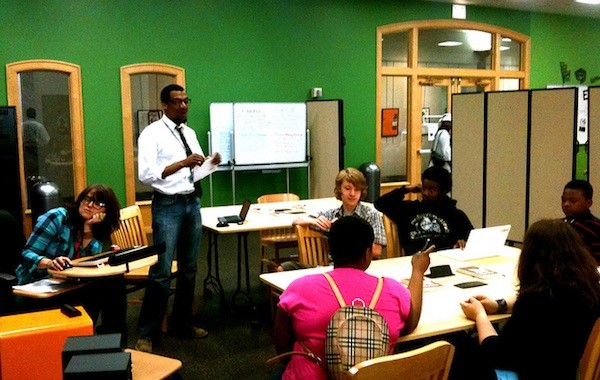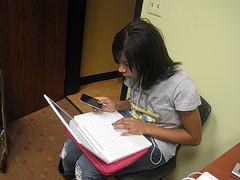"Check-in" Learning and Social Learning Networks

At the core of all of our work at the Digital Youth Network, whether it is understanding the affordances of social learning networks or creating new learner-centered models, is the idea that learners stay engaged by identifying the pathways most interesting and relevant to them. We address this by not only providing a wide array of program options but also designing social learning networks to provide our youth a space outside of structured programming to explore their passions with the support of peers and mentors. Being able to engage our students beyond the limited time and space of workshops and classes not only allows us to continue that work with them throughout the week, but just as important, it gives them a chance to bring invaluable outside experiences into the space to share with the learning community. A great example of this was one of our middle school students, Jalen.
Jalen was already active in our weekly Digital Storytelling media arts course at his school. In this class they’d use digital media, most often video, to produce stories, often based on readings assigned in their literacy class. Jalen, on his own, had begun to go beyond the scope of the class projects to find new ways to apply his skill in video production. At home, he was spending hours exploring Anime Music Videos (AMVs) and learning to build on that core video skill set but on his terms and centered around his own unique passions. He discovered online communities that connected him with others with the same interests and gave him access to tutorials on how to edit this new style of video. He’d been familiar with the tools and the mechanics of editing from his DYN class, but now was being exposed to a new set of styles and techniques. Since Jalen was an active user of Remix World, one of DYN’s social learning networks, he’d often share his AMVs and look for feedback from his friends and mentors. Jalen ended up introducing this genre to his peers and we’d see many of them starting to create their own AMVs, often using the same resources Jalen had.
The important takeaway is to recognize that while the class may have been interesting to Jalen, it did not take him as far as he was willing to go and likely did not tap into the core skill he was most passionate about. Jalen and his peers have access to a wealth of resources to explore their interests through the Internet, family, out of school programs and friends. The challenge presented to us is to empower them to consistently share those interests and activities that happen elsewhere and that paint a fuller portrait of who they are as learners. If this is in place and we have a growing “profile” of learner interests and activities, it creates new opportunities for mentors and peers to support and learn from their efforts. In Jalen’s case, his DYN mentors could have explored ways to connect his AMV work to his digital storytelling course. Jalen himself could help his friends leverage the same resources he’d used to become an advanced producer of these videos. Our social learning network gave Jalen the space to let his mentors and peers know that he had continued down this path on his own, but how might we have provided some mechanism to know that many of the same skills he was developing in class were also now being honed online?
As kids have more connectivity and access to resources than ever, one challenge is to develop new practices and tools to support them in how they choose to manage learning opportunities. How can youth better keep track of their learning across place and space and how do peers, parents and mentors work with them to make effective connections among these experiences?
Expanding the Check-in Model
We’re most familiar with check-in’s as a part of location based services like FourSquare, Gowalla & Facebook Places. These services allow you to check-in to a location you visit, see where your friends are and receive tips on things to do, which in theory, lead you to discovering new ways to explore your city. While many of these services have yet to show they provide much value to most of us for traditional use, if we look at what these tools provide there is room to find creative uses in support of learning. 
For instance, this ProfHacker post offers ideas on how Gowalla can be used in education to create new ways to interact with literature. Our colleagues in the New Youth City Learning Network are working on Mannahatta: The Game, a location-based game for the iPhone that maps Manhattan’s historical ecosystem to modern day streets. Educators whose students already use GPS systems for community projects could easily streamline and enhance those same activities by using new or existing location based services. There’s plenty of potential yet to be realized in using location based services to create new ways for youth to learn by exploring the environment around them.
Looking specifically at the check-in functionality of these services, how can this kind of self-reporting be leveraged to understand more about student interests and the learning resources that they already take advantage of? If one of our goals is connecting learning across space, can a check-in model be used to help facilitate these connections?
The Chicago Learning Network is a MacArthur Foundation supported initiative to connect youth interest driven learning across institutions. The network is made up of dozens of the city’s museums, libraries and afterschool programs that are creating new collaborative programs across institutions as well as developing a social learning network for participating youth to connect with peers and mentors online.
As a part of our work with the Chicago Learning Network, we are working with youth to better understand what resources they currently tap into, what’s missing, how they identify and select new activities and resources and their motivations for doing so. A youth summit was held earlier this year to start to address many of these questions. As a follow up to this, we decided to have a group of teens go out for a month to begin work on constructing their own activity map. We provided them with mobile phones equipped with GPS and a data plan and asked them to use Gowalla to track the activities they participate in, the places they visit that mean the most to them and quick observations on their experiences. The students are using their mobile phones to check-in and comment on their time at school, afterschool programs, volunteer activities, outings with friends and more. After 30 days we’ll work with them to reflect on the individual and group trends on how they spend their time, their motivations and takeaways for those experiences and ultimately use that data to take a stab at starting to map out their learning network. It’ll be very interesting to see what experiences teens see as important, which were driven by interests and which by social motivations (or both) and where the kids themselves identify significant learning as happening.
While we don’t imagine this single activity can paint the full picture for every student, our hope is that what we learn can inform how we structure programming and develop better student-centered strategies to support youth in managing and connecting the learning that’s happening everyday across all of the nodes on their network. 
Beyond Location: Checking-in to Content
There are new approaches to check-ins that go beyond location that hold a lot of potential. Services like GetGlue and Meebo essentially allow you to check-in to content instead of a physical location. Meebo allows you to check-in to websites while GetGlue lets you check-in and let us know what book you’re reading, music you’re listening to, topic you’re pondering and more. The ability to share a link or tell all of my online friends what I am doing is clearly not new. I can do all of the above through status updates on Facebook or Twitter. The distinction here is that a check-in on these services doesn’t just update your status; it connects you to a set of resources about that particular content. If I check-in to say that I’m watching "60 Minutes" or thinking about social networks, it will connect me to a page that has related content, lists other users with similar interests, has user reviews and more. My stated interest in a piece of content or topic now connects me to a space to explore and reflect further as well as discover new things and people that may interest me.
While a service like GetGlue is oriented towards entertainment, a similar approach could be used in a learning context. This same type of social discovery and individualized recommendation system could easily be integrated into a social learning network. Broaden the focus of the service, allow users to similarly check-in to and review programs and activities and we could see a system where youth and mentors are creating authentic connections between learning experiences with ease.
At Digital Youth Network, we are developing an app for our social learning networks that allows our users to have a similar interaction around books. We will integrate with GoodReads.com (using their wonderful API) to access the catalog of titles, allow users to create book lists and share which titles they are currently reading. They’ll be able to share what they are reading, discover new titles from their friends and post reviews. They’ll also, however, be able to contribute to a “living” book profile. Each title’s profile will hold all of the community’s reviews and ratings, student media (blogs, video, music, design, games) created in response to prompts around the title as well as wiki-style character profiles developed by the users. Ideally, youth will not only be able to keep up with what their peers are reading, but also have the chance to engage with titles in new ways by getting access to a growing list of related reviews, media and insights posted by peers who have also read the book.
Challenges and Open Questions
Exploring re-appropriation of existing check-in models likely would reveal opportunities to apply more intent and purpose to the disposition toward (what is often perceived as) “over sharing” by some online. If we can shift this type of interaction, in how it’s perceived and used, from simply a broadcast mechanism to a trigger that reveals new timely resources and supports, I would imagine others would begin to see more utility in it.
Applying this model in a learning context would face many of the same issues and challenges that current services are facing today. While I’m a relatively frequent FourSquare user, neither mayorships nor swarm or superstar badges really motivate me. They’ve yet to make an effective enough value proposition to persuade enough users that they should check-in. If this model was used in a learning space, how do we assure that youth see value in what comes from the check-in?
What are the necessary privacy controls needed to protect youth while still allowing them to leverage the experience and input of trusted peers and mentors? How do the roles of mentors, teachers and parents change when the majority of a kid’s learning takes place outside of their purview?
Programs like ours are being presented with new challenges in building critical skills that complement and build on the full spectrum of experiences in our students’ lives. As we move into 2011, many of DYN’s efforts will be focused not only on developing youth digital literacy skills through direct programming (in and out of school) but further leveraging social learning tools (and re-appropriating existing commercial social tools) to allow youth themselves to drive the creation of their own learning pathways with support of educators.
Banner image credit: YouMedia @Chicago Public Library http://www.flickr.com/photos/youmediachicago/4728553402/in/photostream/
Secondary images credit: Digital Youth Network iremixphoto http://www.flickr.com/photos/digitalyouthnetwork/4291941847/